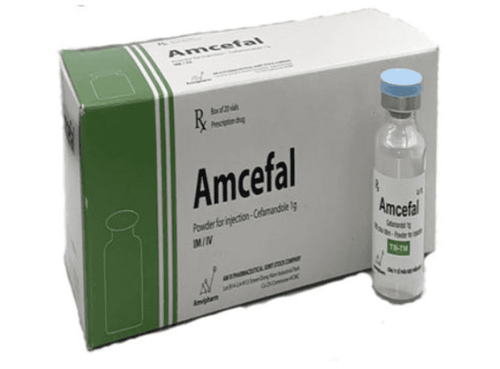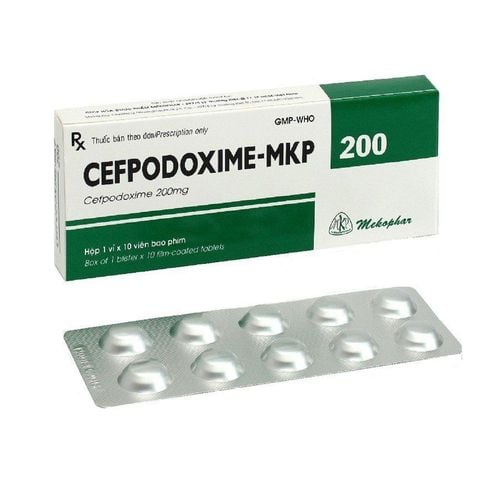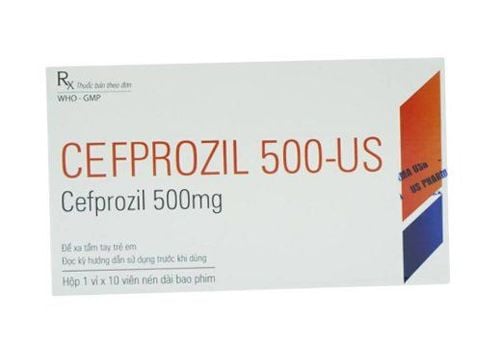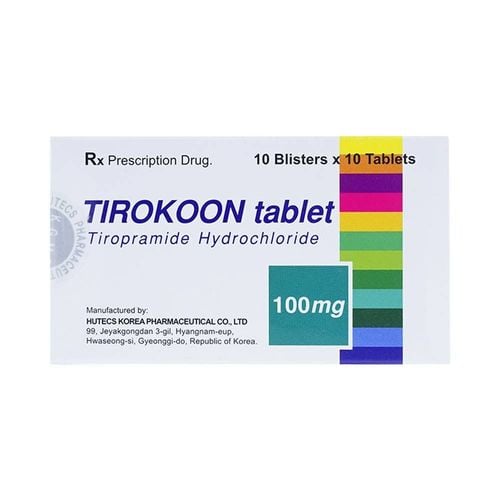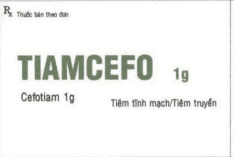This is an automatically translated article.
Tenafatin has 2 forms, Tenafathin 500 and Tenafatin 1000, containing the main ingredient Cefalothin. Tenafatin is used to treat bacteremia, complicated respiratory and urinary tract infections,...
1. What is Tenafatin?
Tenafatin belongs to the group of drugs used to treat parasites, anti-infectives, antivirals, antifungals. Tenafatin is prepared in the form of a powder for injection packed in a box of 1 vial + 1 ampoule of 10ml distilled water for injection and a box of 10 vials + 10 ampoules of 10ml distilled water for injection.
Tenafatin 500 has the main ingredient is Cephalothin (in the form of Cephalothin sodium) 500mg and other excipients just enough for 1 tablet.
Tenafatin 1000 has the main ingredient is Cephalothin (in the form of Cephalothin sodium) 1000mg and other excipients just enough for 1 tablet.
2. Indications for taking Tenafatin
Tenafatin is used in the following cases:
As the second choice for the treatment of complicated bacterial infections. Tenafatin is an alternative to Penicillin for the treatment of infections caused by susceptible gram-negative cocci and gram-negative bacilli. Sepsis . Inflammation of the endocardium. Osteomyelitis. Other serious infections. Urinary tract infections such as: nephritis, cystitis, pyelonephritis. Respiratory tract infections: Bronchitis, severe pneumonia, lung abscess. Surgical infections: Post-operative infections, abdominal abscesses, peritoneal abscesses. Purulent pleurisy. Severe intestinal infections.
3. Dosage, how to use Tenafatin
3.1. Dosage of Tenafatin 500 Adults:
Usual dose: Intramuscular or intravenous injection 0.5 - 1g Cephalothin / time, each time 4-6 hours apart, depending on the degree of infection. Severe infections: Intravenous 2g Cephalothin/time x 4 times/day. Life-threatening illness: The dose may be increased to 12g Cephalothin/day. Every 4 hours, inject 2g Cephalothin / time. Adults with renal failure need to reduce the dose of Cephalothin:
Intravenously 1 - 2g Cephalothin with the starting dose. Then adjust the next dose of Cephalothin based on the creatinine clearance as follows: Creatinine clearance 50 - 80ml/min: Every 6 hours, inject 2g Cephalothin/time. Creatinine clearance 25 - 50ml/min: Every 6 hours, inject 1.5g Cephalothin/time. Creatinine clearance 10 - 25ml/min: Every 6 hours, inject 1g of Cephalothin/time. Creatinine clearance 2 - 10ml/min: Every 6 hours, inject 0.5g Cephalothin/time. Creatinine clearance < 2ml/min: Every 8 hours, inject 0.5g Cephalothin/time. Children:
Usual dose: 80 - 160 mg Cephalothin/kg/day, divided into 3-4 times/day. The maximum dose is 160 mg Cephalothin/kg/day but should not exceed 10 - 12g Cephalothin/day. Treatment of cystic fibrosis in pulmonary infections caused by Staphylococcus aureus: 25-50mg Cephalothin/kg every 6 hours. The total dose of Cephalothin should not exceed the adult dose. Neonates:
Intravenous 25mg Cephalothin/kg every 6 hours. Children should be monitored for symptoms of rash, skin allergies, nephrotoxicity, neutropenia. Fake Coombs(-) test may occur in some cases. Children with moderate renal impairment:
Dose of 70 - 100% of the normal dose of Cephalothin in 12 hours. Children with difficulty urinating take the normal dose of 1⁄2 Cephalothin in 12-24 hours. Prophylaxis of infection or possible infection during surgery:
Adults: Usual dose 30 - 60 minutes before surgery, intravenously 1 - 2g Cephalothin. During and after surgery, every 6 hours, inject 1 - 2g of Cephalothin, used within 24 hours. Children: 30 - 60 minutes before surgery, intravenous injection of 20 - 30mg Cephalothin/kg. During and after surgery, every 6 hours, inject 20 - 30mg of Cephalothin/kg. Prophylaxis usually stops cephalothin within 24 hours of surgery. Peritoneal dialysis-associated peritonitis in patients with anuria:
Intermittent dose: 15mg Cephalothin/kg in one dialysis fluid change/day. Continuous dose: Loading dose is 500mg Cephalothin and maintenance dose is 125mg Cephalothin/l variable dialysate. Cephalothin dose adjustment in dialysis:
Maintenance dose of Cephalothin is recommended for patients after hemodialysis, but do not add Cephalothin dose for people on peritoneal dialysis. 3.2. Dosage and administration of Tenafatin 1000 Adults: 0.5-1 g Cephalothin every 4-6 hours by slow intravenous injection over 3-5 minutes or by continuous or intermittent injection. For severe infections, the dosage is up to 12g of Cephalothin per day.
4. Contraindications to taking Tenafatin
Tenafatin should not be used in the following cases:
Patients with a history of allergy, hypersensitivity to Cephalosporin antibiotics and other Beta Lactams. Patients with hypersensitivity to any of the excipients in the formulation of Tenafatin.
5. Tenafatin drug interactions
Bacteriostatic agents used with Cephalothin are likely to appear antagonistic. Tenafatin in combination with aminoglycoside antibiotics may increase the risk of kidney damage. Probenecid with Tenafatin may inhibit renal excretion of Cephalothin. Loop diuretics such as furosemide in combination with tenafatin have been shown to increase toxicity. Measurement of creatinine levels by the Jaffé method, renal function testing, and cross-reactivity with Cephalothin may interfere with these tests. Direct Coombs test: Gives a false (-) result.
6. What side effects does Tenafatin cause?
During the treatment with Tenafatin, patients may experience some of the following side effects:
Common: Pain at the site of intramuscular injection, sometimes stiffness, diarrhea, bleeding complications, increased white blood cell count. eosinophilia, maculopapular rash. Uncommon: fever, urticaria. Rare: Serum sickness-like reactions and anaphylaxis, hemolytic anemia, nausea and vomiting, neutropenia/thrombocytopenia, positive Coombs' test, pseudomembranous colitis, transiently increased nephrotoxicity uremia/creatinine, cholestatic jaundice, interstitial nephritis, mild elevations of AST, ALT, candidiasis and arthralgia. Using Tenafatin in high doses and for a long time may appear convulsions, signs of central nervous system toxicity, thrombophlebitis after intravenous infusion.
7. Precautions when using Tenafatin
Because cross-sensitivity and anaphylaxis have been observed among patients who are allergic to beta-lactam antibiotics, it is important to be very cautious and ready to treat anaphylaxis when using Tenafatin for people who have previously been treated with anaphylaxis. are allergic to penicillin. However, Tenafatin cross-reactivity with penicillin has a low rate.
Caution when using Tenafatin for people with renal failure: May have to reduce the dose. Concomitant use of Aminoglycosides with Gentamicin is associated with an increased risk of nephrotoxicity. Renal function and blood clotting time should be monitored, especially during long-term, high-dose Tenafatin therapy.
Long-term use of Tenafatin may cause overgrowth of non-susceptible strains, so patients should be carefully monitored. If superinfection occurs, Tenafatin should be discontinued immediately.
Pseudomembranous colitis has been reported with the use of broad-spectrum antibiotics, so it is necessary to diagnose this disease and treat with metronidazole for severe antibiotic-associated diarrhea.
Pregnancy: Tenafatin is used at all stages of pregnancy and is generally considered safe. There are no reports of an association between Tenafatin use with birth defects or neonatal toxicity.
Lactation: Tenafatin is excreted in breast milk in low concentrations. Cephalothin concentrations have no effect on breastfed infants, but caution should be exercised when infants develop diarrhea, thrush, and rash.
Reconstituted Tenafatin solution is stable for 12-24 hours at room temperature 25 degrees Celsius and stored in the refrigerator for 96 hours, solution for intravenous infusion in 0.9% sodium chloride injection or glucose for injection 5% is stable for 24 hours at room temperature.
Above is important information about Tenafatin, patients should carefully read the instructions for use and use according to the dose prescribed by the doctor to achieve the best effect.
Please dial HOTLINE for more information or register for an appointment HERE. Download MyVinmec app to make appointments faster and to manage your bookings easily.




